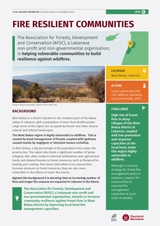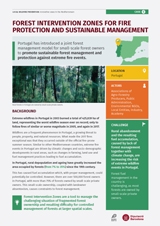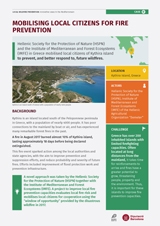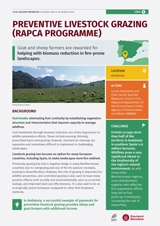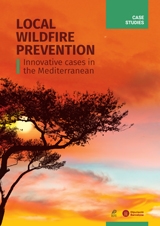Best-practice cases of fire prevention in the Mediterranean
While wildfires are a natural part of ecosystem function, they are also a major environmental and socio-economic threat globally, especially in the context of climate change, and are devastating for local communities. Suppression efforts when a big wildfire occurs inevitably receive great attention, and as a result wildfire management historically has focused on suppression.
However, prevention is increasingly considered the most important approach to wildfire management. Prevention of wildfires includes a multitude of efforts across different scales including policymaking, forest management, education and training. These efforts share the same goal of reducing probability of fire ignition and managing the growth and force of fire events.
It is local prevention practice that can really make a difference for communities at risk from wildfire. Five cases from around the Mediterranean highlight innovative wildfire prevention initiatives, and in particular, how engaging with local communities in prevention efforts is critical for success.
These case studies were compiled by EFI's Mediterranean Facility (EFIMED) in collaboration with the Diputació de Barcelona (Barcelona Provincial Council).
This collection has been enhanced and expanded in 2024.
Read more about the cases:
Case A - Catalonia, Spain: Managing fire risk in the wildland-urban interface | |
Case B - West Bekaa, Lebanon: Building fire resilient communities | |
Case C - Portugal: Forest Intervention Zones for fire protection and sustainable management | |
Case D - Kythira Island, Greece: Mobilising local citizens for fire prevention | |
Case E - Andalusia, Spain: Preventive livestock grazing (RAPCA programme) | |
Introduction & collection of all cases (single document) |
References:
Case A - Catalonia, Spain: Managing fire risk in the wildland-urban interface:
Alcasena, F. J., Ager, A. A., Bailey, J. D., Pineda, N., & Vega-García, C. (2019). Towards a comprehensive wildfire management strategy for Mediterranean areas: Framework development and implementation in Catalonia, Spain. Journal of environmental management, 231, 303-320.
Bento-Gonçalves, A., & Vieira, A. (2020). Wildfires in the wildland-urban interface: Key concepts and evaluation methodologies. Science of the total environment, 707, 135592.
Diputació Barcelona. Programa de Prevenció d’Incendis Forestals en urbanitzacions i nuclis de població (PPU). https://www.diba.cat/en/web/incendis/ppu
Galiana-Martín, L. (2017). Spatial planning experiences for vulnerability reduction in the wildland-urban interface in Mediterranean European countries. European Countryside, 9(3), 577.
Galiana-Martín, L. (2011, May). The wildland-urban interface: a risk prone area in Spain. In: Proceedings of the “5th International Wildland Fire Conference”. Sun City (South Africa) (pp. 9-13).
Generalitat de Catalunya. LLEI 5/2003, de 22 d'abril, de mesures de prevenció dels incendis forestals en les urbanitzacions sense continuïtat immediata amb la trama urbana. Retrieved December 2021, from https://portaljuridic.gencat.cat/eli/es-ct/l/2003/04/22/5.
Pastor, E., Muñoz, J. A., Caballero, D., Àgueda, A., Dalmau, F., & Planas, E. (2020). Wildland–Urban interface fires in Spain: summary of the policy framework and recommendations for improvement. Fire technology, 56(5), 1831-1851.
Radeloff, V. C., Helmers, D. P., Kramer, H. A., Mockrin, M. H., Alexandre, P. M., Bar-Massada, A., Butsic, V., Hawbaker, T. J., Martinuzzi, S., Syphard, A. D., & Stewart, S. I. (2018). Rapid growth of the US wildland-urban interface raises wildfire risk. Proceedings of the National Academy of Sciences, 115(13), 3314-3319.
Case B - West Bekaa, Lebanon: Building fire resilient communities:
Chedid, M., Tourrand, J. F., Jaber, L. S., & Hamadeh, S. K. (2018). Farmers’ perception to change and adaptation strategies of small ruminant systems in the West Bekaa of Lebanon. Small Ruminant Research, 167, 16-21.
Kabakian-Khasholian, T., Mourtada, R., Bashour, H., Kak, F. E., & Zurayk, H. (2017). Perspectives of displaced Syrian women and service providers on fertility behaviour and available services in West Bekaa, Lebanon. Reproductive health matters, 25(sup1), 75-86.
Karouni, A., Daya, B., & Bahlak, S. (2013). A comparative study to find the most applicable fire weather index for Lebanon allowing to predict a forest fire. Journal of Communication and Computer, 11, 1403-1409.
Mitri, G., Jazi, M., & McWethy, D. (2015). Assessment of wildfire risk in Lebanon using geographic object-based image analysis. Photogrammetric Engineering & Remote Sensing, 81(6), 499-506.
Mitri, G., Saba, S., Nader, M., & McWethy, D. (2017). Developing Lebanon's fire danger forecast. International journal of disaster risk reduction, 24, 332-339.
OCHA. (2014). Lebanon: Bekaa Governorate profile. (pp.1). Beirut: United Nations Office for the Coordination of Humanitarian Affairs.
Salloum, L., & Mitri, G. (2014). Assessment of the temporal pattern of fire activity and weather variability in Lebanon. International journal of wildland fire, 23(4), 503-509.
UN. (2017). Lebanon crisis: response plan 2017-2020. Retrieved December 2021, from https://reliefweb.int/sites/reliefweb.int/files/resources/2017_2020_LCRP_ENG-1.pdf.
Case C - Portugal: Forest Intervention Zones for fire protection and sustainable management:
Benali, A., Sá, A. C., Pinho, J., Fernandes, P. M., & Pereira, J. (2021). Understanding the Impact of Different Landscape-Level Fuel Management Strategies on Wildfire Hazard in Central Portugal. Forests, 12(5), 522.
ICNF. Retrieved December 2021, from https://www.icnf.pt/florestas/zif/zifinformacaogeral
Oliveira, S., Gonçalves, A., & Zêzere, J. L. (2021). Reassessing wildfire susceptibility and hazard for mainland Portugal. Science of the total environment, 762, 143121.
Tedim, F., Remelgado, R., Borges, C., Carvalho, S., & Martins, J. (2013). Exploring the occurrence of mega-fires in Portugal. Forest Ecology and Management, 294, 86-96.
Valente, S., Coelho, C., Ribeiro, C. & Soares, J. (2013). Forest intervention areas (ZIF): a new approach for non-industrial private forest management in Portugal. Silva Lusitana, 21(2), 137-161.
WWF (2017). WWF-CEABN / ISA Report: Wildfires in Portugal: a forest on fire. Retrieved December 2021, from https://d2ouvy59p0dg6k.cloudfront.net/downloads/wwf_portugal_report.pdf.
Case D - Kythira Island, Greece: Mobilising local citizens for fire prevention:
Palaiologou, P., Kalabokidis, K., Troumbis, A., Day, M. A., Nielsen-Pincus, M., & Ager, A. A. (2021). Socio-Ecological Perceptions of Wildfire Management and Effects in Greece. Fire, 4(2), 18.
Xanthopoulos, G., Athanasiou, M., Nikiforaki, A., Kaoukis, K., Mantakas, G., Xanthopoulos, P., ... & Varela, V. (2022). Innovative Action for Forest Fire Prevention in Kythira Island, Greece, through Mobilization and Cooperation of the Population: Methodology and Challenges. Sustainability, 14(2), 594.
Case E - Andalusia, Spain: Preventive livestock grazing (RAPCA programme):
European Commission. DG Environment Inventory of Results-Based Agri-Environment Schemes. Retrieved December 2021, from http://ec.europa.eu/environment/rapca-red-de-areas-pasto-cortafuegos-deandalucia-_en.htm.
De Rancourt, M., Fois, N., Lavín, M. P., Tchakérian, E., & Vallerand, F. (2006). Mediterranean sheep and goats production: An uncertain future. Small Ruminant Research, 62(3), 167-179.
Herrera, P. (2014). Searching for extensive livestock governance in inland northwest of Spain: Achievements of two case studies in Castile-Léon. In P.M., Herrera, J., Davies & P.M. Baena (Eds.), The Governance of Rangelands: collective action for sustainable Pastoralism. Routledge.
Junta de Andalucia. INFOCA Plan: Wildfire Prevention and Suppression Plan of Andalucia. Retrieved December 2021, from https://www.juntadeandalucia.es/medioambiente/portal/documents/prevencion_incendio.pdf.
Junta de Andalucía (2). Red de Áreas Pasto-Cortafuegos de Andalucía (RAPCA). Retrieved December 2021, from https://www.juntadeandalucia.es/medioambiente/portal/red-de-c3-a1reas-pasto-cortafuegos-de-andaluc-c3-ada-rapca-/20151.
Lovreglio, R., Meddour-Sahar, O., & Leone, V. (2014). Goat grazing as a wildfire prevention tool: a basic review. Iforest-Biogeosciences and Forestry, 7(4), 260.
Ruiz-Mirazo, J., Robles, A. B., & González-Rebollar, J. L. (2011). Two-year evaluation of fuelbreaks grazed by livestock in the wildfire prevention program in Andalusia (Spain). Agriculture, Ecosystems & Environment, 141(1-2), 13-22.
Varela, E., Górriz-Mifsud, E., Ruiz-Mirazo, J., & López-i-Gelats, F. (2018). Payment for targeted grazing: integrating local shepherds into wildfire prevention. Forests, 9(8), 464. https://doi.org/10.3390/f9080464

